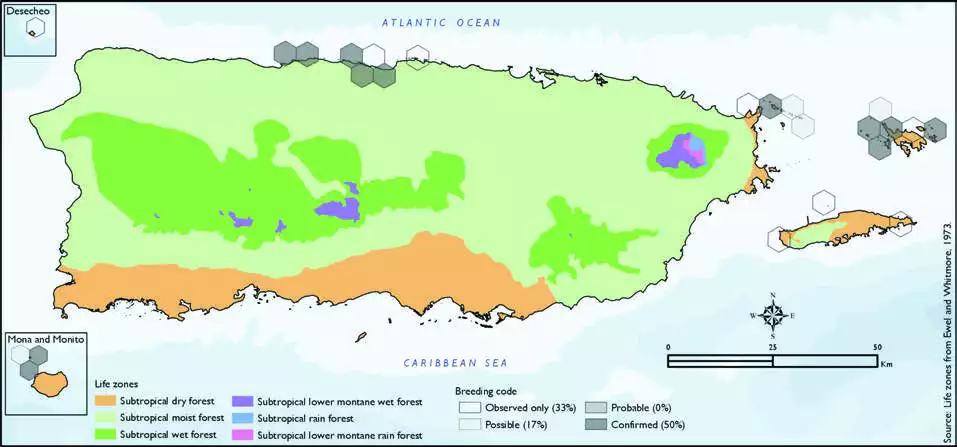Bridled Tern
Description
The bridled tern (Onychoprion anaethetus) is a seabird of the family Laridae. It is a bird of the tropical oceans. The scientific name is from Ancient Greek. The genus comes from onux meaning "claw" or "nail", and prion, meaning "saw". The specific anaethetus means "senseless, stupid".
This is a medium-sized tern, at 30–32 cm in length and with a 77–81 cm wingspan similar to the common tern in size, but more heavily built. The wings and deeply forked tail are long, and it has dark grey upperparts and white underparts. The forehead and eyebrows are white, as is a striking collar on the hindneck. It has black legs and bill. Juvenile bridled terns are scaly grey above and pale below.
Distribution & Habitat
The Bridled Tern occurs throughout the tropical and
subtropical seas of the world
(Raffaele and others 1998). It
is a resident species in Puerto
Rico (Raffaele and others 1998),
regularly seen during breeding
season in waters off Mona
and Monito, as well as in the
Cordillera Natural Reserve and
Culebra (Kepler 1978, Oberle
2018), but it is an extremely
rare spring and summer visitor
in Vieques (Gemmill 2015).
However, during the breeding
season it can also be seen
commonly on the north coast
of Puerto Rico between Isabela and Barceloneta (Oberle 2018).
This species often occurs far
offshore (Raffaele and others
1998) or near islets where it
breeds (Oberle 2018, Raffaele
and others 1998). The atlas
fieldwork yielded a total of 37
records within 24 hexagons or 5
percent of the 479 total hexagons
(see map). Of the 24 hexagons
where this species was found,
breeding met the atlas definition
of confirmed in 50 percent (12)
of the hexagons and possible in
17 percent (4), while the species
was observed in 33 percent (8)
of the hexagons but without
evidence of breeding (see map).Bridled Tern distribution. The map shows the highest breeding code by hexagon and overlaying the ecological life zones in
Puerto Rico. Note: percentages may not total 100 due to rounding. 119Bridled Tern/Charrán Monja

Breeding Habits
The Bridled Tern nests in small colonies on a coral rubble
beach or under the protection of
vegetation and rocks on isolated
islands or cays from April to
July, according to previously
published reports (Oberle 2018,
Raffaele and others 1998). Atlas
results indicate that this species
mostly breeds in May, June, and
July (see chart). Results show
that breeding most commonly occurs in the subtropical dry
and subtropical moist forest life
zones (69 and 31 percent of the
hexagons, respectively) (see
table and map).
Conservation
Although the overall population trend of the Bridled Tern is
uncertain, it is listed as a species
of least concern by the IUCN
(BirdlLife International 2019),
and locally it is not listed in any of the threatened categories
used by PRDNER and USFWS.
In Puerto Rico, the Bridled Tern
has a protected habitat in land of
6 percent or 23 km2 of the total area covered by the hexagons
where evidence of breeding was
found for this species (382 km2).
Related Species
Family:
gull